Abstract
This research is the first in our Algerian cement factories to assess the attitude and cultural level of cement plants in terms of occupational health and safety, initiate a sustainable development strategy, and engage in a process of continuous improvement. Its objective is to provide strategic decision-making support for managing the risks facing our cement plants and improving the quality of life at work. As a result, measuring the quality of life at work has become an essential element in improving living conditions for the employee, his family, and society as a whole. It is an essential component of sustainable development in nations and an encompassing concept, broader in scope than the notions of physical and mental health or even public health, for a better life in activity and retirement. The methodology consists of a survey of employees of different cement plants to enable us to determine the elements to be improved in health and safety at work, including with regard to the organizational and financial aspects of the latter. It is based on an in-situ observation. As a result, such an initiative makes it possible to build a global and sustainable strategy in health and safety at work in order to avoid damage and losses while achieving their objectives, or even managing to prevent accidents and occupational diseases. As a result, it is possible to provide elements of support for the evaluation of the sustainable development strategy and its good governance within Algerian cement factories, as well as very significant social and economic benefits in cement factory management. As a case study, we have chosen three cement factories in eastern Algeria.
1. Introduction
It is apparent from our participation in the 3rd International Electronic Conference on Environmental Research and Public Health that the work deserves to be published if it is further improved [1]. Thus, and following a study carried out in an Algerian cement plant, rational management of industrial health and safety is essential and becomes one of the essential conditions for compliance with hygiene rules, not only for employees but also in the general environment [2]. On the basis of these results, we want to know through this work the real situation of occupational health and safety in some cement factories in eastern Algeria in order to launch a sustainable development strategy or even engage in a process of continuous improvement. The latter is an essential component of nations and an encompassing concept, broader in scope than the notions of physical and mental health. This safety culture assessment corresponds to a first step in the approach towards its development. Such an initiative makes it possible to prevent accidents and occupational diseases and promotes the sharing of good practices aimed at supporting the enrichment of the organization’s governance in response to the challenges of sustainable development, thus avoiding serious negative consequences for workers and the company [3,4,5,6]. Overall, everything starts with the principle that a worker has the right to safe working conditions that do not risk having negative consequences for his health, safety, and physical and moral integrity [7,8,9]. Therefore, the cement industry allows the construction of houses, dams, roads, etc., as well as participation in the national economy. However, their impact has a huge influence on health, safety at work, and the quality of the daily working environment. Various publications and surveys have shown that the current hygiene, sanitation, health, safety, and management conditions are not always satisfactory for human health and the environment [10,11,12,13,14]. However, the methods of management and management of health and safety at work recommended require significant technical, organizational, and financial resources as well as a legal framework, which are often lacking in reality [15,16].
Otherwise, all the actions taken so far have proven flawed and disparate. This situation has often led staff to be powerless to manage their health and safety without any training, information, motivation, or guidance on the risks incurred by the various activities within the company. Thus, the measurement of the quality of life at work has become an essential element in the improvement of living conditions for the employee, his family, and society [17,18,19,20]. It is an essential component of sustainable development in nations and an encompassing concept, broader in scope than the notions of physical and mental health or even public health, for a better life in activity and retirement. Considering the quality of life at work can lead to increased employee involvement in company projects [21,22,23], as well as a better match between the needs expressed and the responses to bring in society.
Therefore, in order to identify and control the risks and overcome the problems experienced in organization, management, and hygiene, a cultural level of the cement plant staff must be part of the elementary values of the actors in the world of work in this field. From now on, any organization is responsible for the occupational health and safety of its workers and other people who may be affected by its activities. This responsibility includes promoting and preserving their physical and mental health [24]. Thus, and on the basis of this legislation, we try to carry out our study.
In this context, we try through this contribution to evaluate the attitude and the cultural level of the personnel of the cement factories in risk management with the aim of promoting the latter in our cement factories and thus to establish and adapt the techniques and the most appropriate measures: engage in a process of continuous improvement while relying on precise regulations. As a case study, we have chosen three cement factories in eastern Algeria. Indeed, establishing a culture of health and safety at work consists of putting in place policies and directives that promote the values of the quality of life at work, the well-being of employees, the moral and physical safety of the workforce, and the work of the company in general. Therefore, the measurement of the safety culture appears as a proactive indicator of health and safety at work, which makes it possible not to wait for the system to fail to identify its weaknesses and put in place actions to remedy them [25,26].
Consequently, it is recommended to identify, upstream, all the risk factors having a negative impact on the working climate and the health of the workers, or even any deterioration in the state of health of the worker having an impact on his functional capacities and on his work [27]. Recently, it has been demonstrated that the integration of occupational safety and health into the activities of the company is very beneficial for the company in terms of economic quality [28,29,30], because it allows not only to reduce the number of accidents but also to increase the productivity and the economic and financial results of the company. Subsequently, developing a strong safety culture would be a way to reduce the number of adverse events related to various activities in companies [31,32,33]. This safety culture, based on laws, standards, and legislation, is represented by all the best practices, customs, and behaviors developed and applied by the main players concerned to control the risks of their profession [34]. From now on, the consequences of these factors will lead to functional limitations having repercussions on their quality of life at work and the quality of their work, even on the intended performance of the company [35]. Thus, I manage to suggest avenues for improvement, which is the objective of this present work.
2. Methodology of Work
Various methods and approaches have been designed to study knowledge of the security situation and tend to understand and measure the progress of security behaviors with a view to establishing a lasting and effective security culture in companies [36,37]. The qualitative assessment of the safety culture is generally based on the results of interviews, observations, audits, and documentary analysis to collect all the necessary information. Employees play a key role in encouraging the company to develop strategies to improve safety at work [38,39,40]. Therefore, our study is based on an in situ observation. The working method envisaged is based on the feedback from the different categories of employees, an a posteriori approach, events manifested in the national cement factories of eastern Algeria [41,42], a data-driven approach, and even the reality of cement plant personnel. It consists of a survey of cement plant employees to enable us to determine the elements to be improved in health and safety at work (i), including with regard to the organizational aspect of the latter. All the information collected in the field is presented through simple and tabulated summaries (ii), the purpose of which is to have an overview of the distribution of these deficiencies observed in the workplaces within the different cement plants of study. Then, analyze these results to help decide on actions and recommendations that meet the expectations of employees, cement plants, and society in general (iii). To then determine what measures to adopt for the proper functioning of the company and prevent the damage from materializing a second time (vi), at least mitigate it, or even manage to suggest improvements to the deficiencies observed in the workplace. This survey is based on dependent variables, and their indicators are related to the assumptions and objectives of our work. It includes direct questions that collect information likely to verify the hypotheses formulated. The population of our study is made up of a set of staff from different functions at the three cement factories in eastern Algeria. The questionnaire was distributed randomly, without any selection. The sample size was determined using a sampling technique based on a recommended probability method [43]. Our sample is made up of the personnel of these three cement factories, which are respectively 78 employees (6 women and 72 men) for the Hamma Bouziane cement factory, 98 (20 women and 78 men) for the Hadjar soud cement factory, and 87 (15 women and 72 men) for the Elma Labiod cement plant, broken down as follows in Table 1.

Table 1.
Actual distribution.
The proposed approach will make it possible to analyze the actual situation in health and safety at work and the weaknesses identified in order to put in place effective actions to improve the weak points identified. These last elements provide support elements for prioritizing improvement actions within the framework of an overall program of sustainable development at the level of cement plants [44].
3. Result and Discussion
The analysis of the results of our survey is shown in the following figures:
3.1. Cause 1: Lack of Experience and Motivation
Finding: These results (Figure 1) clearly show that the categories of employees most affected by this cause in the three cement plants are the youngest and least experienced age groups (22–27). This may be due to a lack of experience and a low level of training and information. However, for the oldest age group (46–51), this may be due to a lack of motivation in preparing for retirement. The same remarks apply for the three cement factories.
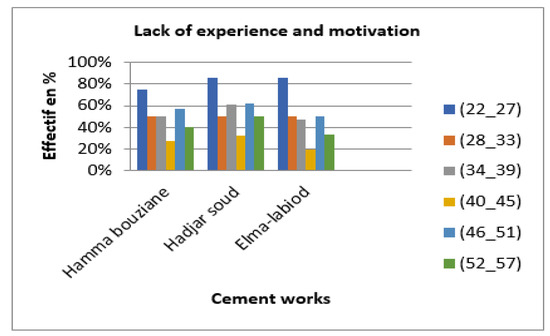
Figure 1.
Distribution according to lack of experience and motivation.
3.2. Cause 2: Difficult Working Conditions
Finding: Here (Figure 2), we also note that the categories of employees most concerned by this chronicle are (22–27) and (46–51), due to the lack of experience in the first age category and the low reaction due to aging in the second age category. These two categories are linked by age, except that the first is related to a lack of experience and the second to a lack of responsiveness. The same remarks apply to the three cement plants.
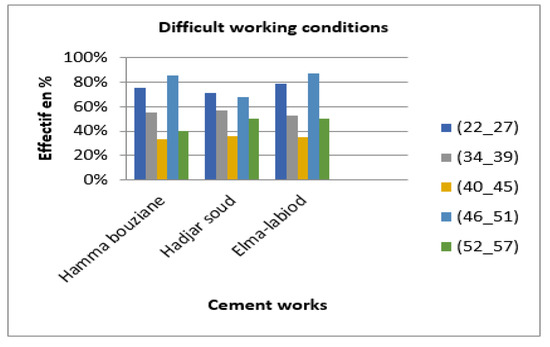
Figure 2.
Distribution according to difficult working conditions.
3.3. Cause 3: Insufficient Machine Safety
Finding: Here, we note that the categories of employees (28–33) and that of (52–57) are the most affected by the category of insufficient machine safety as a cause of work accidents (Figure 3). In our view, this can be explained by the category (28–33) that has already acquired some experience and by their direct exposure to the different machines, since most of them are operators and therefore usually face the different machines on site. However, for the most experienced category of workers (52–57), this is due to the different workplaces occupied during their careers and their repeated exposures to different unsecured machines. The same remarks apply to the three cement plants.
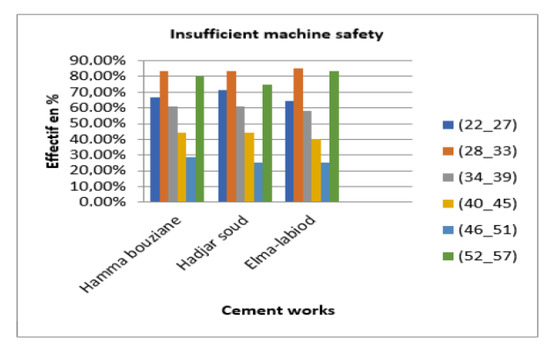
Figure 3.
Distribution according to insufficient machine safety.
3.4. Cause 4: Stress
Finding: As the main cause of a high number of accidents at work in cement factories, we note here that the category of young employees (22–27) and the category of older employees (46–51) and (52–57) are the most affected (Figure 4). This can be explained for young employees by the fact that they are not yet used to their work and also by the nature and working conditions that require physical and mental effort. However, for the other two categories, the more experienced suffer from stress due to the very difficult working conditions, age, and responsibility. The same remarks apply to the three cement plants.
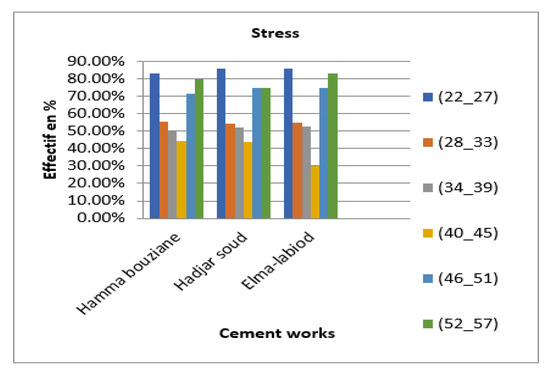
Figure 4.
Distribution according to stress.
3.5. Cause 5: Insufficient Involvement of Employees and Management
Finding: In the Figure 5, we note that the categories of the most experienced workers who find that the causes of accidents at work are due to the insufficient involvement of employees and management. This can be explained by the lack of communication between the different hierarchical levels and the lack of involvement of the different categories in decision-making.
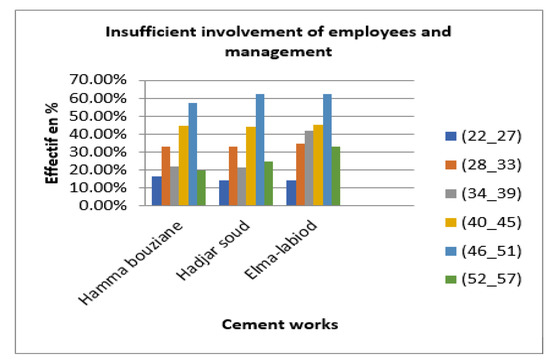
Figure 5.
Breakdown according to the insufficient involvement of employees and management.
3.6. Cause 6: Presence of Burn-In or Presenteeism
Finding: The Figure 6 shows that the age categories (28–33), (34–39), followed by the categories (46–51), and (52–57), attributed the causes of work accidents to burn-in or presenteeism. This can be explained by their knowledge of the importance of physical and mental well-being in the performance of tasks assigned to their workstations and how this syndrome can influence their performance. In our view, this difference in response is due to the task performed, the nature of the work, and the position occupied.
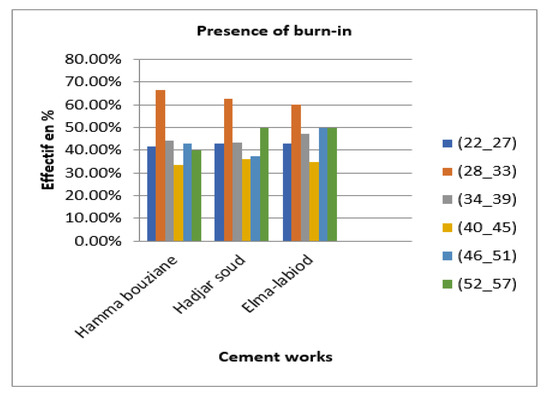
Figure 6.
Distribution according to the presence of burn-in or presenteeism.
3.7. Cause 7: Other Causes
Finding: The Figure 7 clearly shows that it is experience that speaks. In our opinion, these categories are the most experienced; they have extensive knowledge of the site and the various existing problems, and they have also experienced various work accidents during their careers.
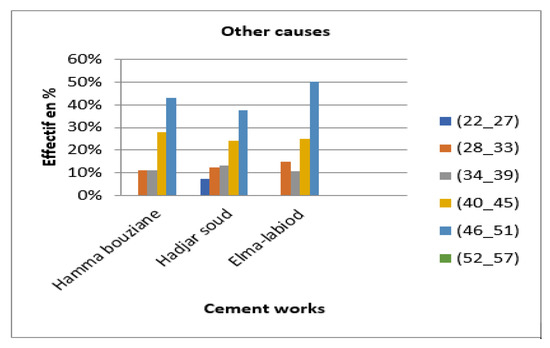
Figure 7.
Distribution according to other causes.
4. Conclusions and Recommendations
According to the results obtained in this study, all the actions carried out so far have turned out to be faulty and disparate, and the staff is often powerless to manage their health and safety without any training, information, or orientation on the risks incurred by the various activities. The results of the survey clearly show that the three cement plants are at the same cultural level in terms of occupational health and safety, with barely a few differences in the figures. As a result of our investigation, it was seen that there is a:
- -
- Lack of a comprehensive prevention approach.
- -
- Insufficient OSH awareness among employees and management.
- -
- Lack of knowledge of OSH regulations.
- -
- A considerable lack of communication and ethical reflection.
- -
- Lack of experience and motivation.
As a result, and following our work results, in order to help OHS managers in Algerian cement and cement plants in general reduce work accidents while improving the safety culture, which leads to improved performance in this area and competitiveness on the market, we offer all the following recommendations based on the general principles and best practices for preventing occupational risks:
- -
- Promote, enhance, inform, and train in OSH.
- -
- Use feedback. It can serve as a basis for undertaking future preventive actions.
- -
- Develop training and welcome programs for new recruits as well as continuing training for employees, without forgetting social dialogue (with employee representatives).
- -
- Harmonize the health and safety policy with other company policies.
- -
- Promoting a multi-disciplinary approach (technical, human, and organizational.
- -
- Analyze work accidents and occupational diseases by going back to their most upstream causes.
Author Contributions
Conceptualization: M.A.; Methodology: M.A.; Software: M.A.; Validation: M.A., R.C. and I.V.; Formal analysis: M.A.; Investigation: M.A.; Resources: M.A. and R.C.; Data curation: M.A.; Writing—original/draft preparation: M.A.; Writing—review and editing: M.A. and R.C.; Visualization: M.A.; Supervision: R.C. and I.V.; Project administration: R.C. All authors have read and agreed to the published version of the manuscript.
Funding
This research received no external funding.
Institutional Review Board Statement
Not applicable.
Informed Consent Statement
Not applicable.
Data Availability Statement
Not applicable.
Conflicts of Interest
The authors declare no conflict of interest.
References
- Abdi, M.; Chaib, R.; Verzea, I. Contribution to the evaluation of the cultural level of hygiene and industrial safety at the level of algerian cement factories. In Proceedings of the 3rd International Electronic Conference on Environmental Research and Public Health—Public Health Issues in the Context of the COVID-19 Pandemic. Available online: https://sciforum.net/paper/view/conference/9014 (accessed on 10 July 2020).
- Rachid, C.; Ion, V.; Irina, C.; Mohamed, B. Preserving and Improving the Safety and Health at Work: Case of Hamma Bouziane Cement Plant (Algeria). In Safety Science; Elsevier: Amsterdam, The Netherlands, 2015; Volume 76, pp. 145–150. [Google Scholar]
- Moldavska, A.; Welo, T. A Holistic approach to corporate sustainability assessment: Incorporating sustainable development goals into sustainable manufacturing performance evaluation. J. Manuf. Syst. 2019, 50, 53–68. [Google Scholar] [CrossRef]
- Andrew, S. The Triple Bottom Line: How Today’s Best-Run Companies are Achieving Economic, Social and Environmental Success-and How you Can Too; John Wiley & Sons: Hoboken, NJ, USA, 2013. [Google Scholar]
- Zwetsloot, G.I.; Kines, P.; Wybo, J.L.; Ruotsala, R.; Drupsteen, L.; Bezemer, R.A. Zero Accident Vision based strategies in organisations: Innovative perspectives. Saf. Sci. 2017, 91, 260–268. [Google Scholar] [CrossRef]
- Dyakova, M. Investment for Health and Well-Being: A Review of the Social Return on Investment from Public Health Policies to Support Implementing the Sustainable Development Goals by Building on Health 2020; WHO: Geneva, Switzerland, 2017. [Google Scholar]
- Viscusi, W.K. Regulation of health, safety, and environmental risks. In Handbook of Law and Economics; Elsevier: Amsterdam, The Netherlands, 2007; Volume 1, pp. 591–645. [Google Scholar]
- Preibisch, K.; Otero, G. Does Citizenship Status Matter in C anadian Agriculture? Workplace Health and Safety for Migrant and Immigrant Laborers. In Rural Sociology; Wiley Online Library: Hoboken, NJ, USA, 2014; Volume 79, pp. 174–199. [Google Scholar]
- Glendon, A.I.; Clarke, S.; McKenna, E. Human Safety and Risk Management; CRC Press: Boca Raton, FL, USA, 2016. [Google Scholar]
- Badri, A.; Gbodossou, A.; Nadeau, S. Occupational health and safety risks: Towards the integration into project management. Saf. Sci. 2012, 50, 190–198. [Google Scholar] [CrossRef]
- Dixon-Woods, M.; Baker, R.; Charles, K.; Dawson, J.; Jerzembek, G.; Martin, G. Culture and behaviour in the English National Health Service: Overview of lessons from a large multimethod study. BMJ Qual. Saf. 2014, 23, 106–115. [Google Scholar] [CrossRef] [PubMed]
- Oakden, J.P. The Application of Complexity Theory to Contracting out Public Health Interventions: A Thesis Presented in Fulfilment of the Requirements for the Degree of Master of Philosophy, School of Health at Massey University, Wellington, New Zealand. Ph.D. Thesis, Massey University, Palmerston North, New Zealand, 2019. [Google Scholar]
- Carney, G. Retention, Motivation and Burnout amongst Millenials: An Investigation into Whether These Factors Differ amongst Permanent Employees and Contingent Employees. A Qualitative Study. Ph.D. Thesis, National College of Ireland, Dublin, Ireland, 2019. [Google Scholar]
- aux Opportunités, P.D.D.; Inter-Organisationnel pour la Gestion Rationnelle des Produits Chimiques (IOMC). Directives Pour établir des Stratégies Nationales de Gestion des Déchets: Passer des Défis aux Opportunités; Programme des Nations Unies pour l’Environnement: Dublin, Ireland, 2013; ISBN 978-92-807-3357-0. [Google Scholar]
- Jain, P.; Pasman, H.J.; Waldram, S.; Pistikopoulos, E.N.; Mannan, M.S. Process Resilience Analysis Framework (PRAF): A systems approach for improved risk and safety management. J. Loss Prev. Process Ind. 2018, 53, 61–73. [Google Scholar] [CrossRef]
- Manu, P.; Mahamadu, A.M.; Nguyen, T.T.; Ath, C.; Heng, A.Y.T.; Kit, S.C. Health and safety management practices of contractors in South East Asia: A multi country study of Cambodia, Vietnam, and Malaysia. Saf. Sci. 2018, 107, 188–201. [Google Scholar] [CrossRef]
- Vischer, J.C.; Wifi, M. The effect of workplace design on quality of life at work. In Handbook of Environmental Psychology and Quality of Life Research; Springer: Cham, Switzerland, 2017; pp. 387–400. [Google Scholar]
- Taleb, M.; Bouzerara, R.; Chaib, R. Contribution to the Evaluation of the Quality of Life at Work (Qwl) By Pensioners in Algerian Enterprises. J. Environ. Occup. Health 2020, 10, 48–54. [Google Scholar]
- Jones, S.; White, S.; Ormrod, J.; Sam, B.; Bull, F.; Pieh, S.; Gopalakrishnan, S.; van den Broek, N. Work-based risk factors and quality of life in health care workers providing maternal and newborn care during the Sierra Leone Ebola epidemic: Findings using the WHOQOL-BREF and HSE Management Standards Tool. BMJ Open 2020, 10, e032929. [Google Scholar] [CrossRef]
- Amrani, M.; Chaib, R.; Bouzaouit, A.; Ion, V. Well-being at work: A lever for sustainable performance in workplace. Min. Sci. 2020, 27, 89–104. [Google Scholar] [CrossRef]
- Anitha, J. Determinants of employee engagement and their impact on employee performance. In International Journal of Productivity and Performance Management; Emerald Group Publishing Limited: Bentley, UK, 2014. [Google Scholar]
- Mohamed Abd Elghany Abd Rabo, M. The Effect of Quality of Work Life on Employee Engagement in the Egyptian Electricity Transmission Company (An Applied Study). المجلة العلمية للإقتصاد و التجارة 2018, 48, 731–798. [Google Scholar] [CrossRef]
- Liu, G.; Liston-Heyes, C.; KO, W.-W. Employee participation in cause-related marketing strategies: A study of management perceptions from British consumer service industries. J. Bus. Ethics 2010, 92, 195–210. [Google Scholar] [CrossRef]
- ISO 45001: 2018. Available online: https://www.iso.org/standard/63787.html (accessed on 15 July 2020).
- Flin, R. Measuring safety culture in healthcare: A case for accurate diagnosis. Saf. Sci. 2007, 45, 653–667. [Google Scholar] [CrossRef]
- Essehmoudi, A.; El Hammoumi, M. La Contribution de la Culture de Sécurité à L’amélioration de la Sécurité des Opérateurs de la Maintenance (Cas d’une Entreprise Papetière), 2016, HAL Id: Hal-01260801. Available online: https://hal.archives-ouvertes.fr/hal-01260801 (accessed on 12 July 2020).
- Glen, P.; Kenny Jane, E. Yardley Lucie Martineau Ollie Jay, Physical work capacity in older adults: Implications for the aging worker. Am. J. Ind. Med. 2008, 51, 610–625. [Google Scholar]
- Loeppke, R.R.; Hohn, T.; Baase, C.; Bunn, W.B.; Burton, W.N.; Eisenberg, B.S.; Ennis, T.; Fabius, R.; Hawkins, J.; Hudson, W.; et al. Integrating health and safety in the workplace: How closely aligning health and safety strategies can yield measurable benefits. J. Occup. Environ. Med. 2015, 57, 585–597. [Google Scholar] [CrossRef] [PubMed]
- Taliento, M.; Favino, C.; Netti, A. Impact of environmental, social, and governance information on economic performance: Evidence of a corporate ‘sustainability advantage’from Europe. Sustainability 2019, 11, 1738. [Google Scholar] [CrossRef]
- Eeckelaert, L.; Dhondt, S.; Oeij, P.; Pot, F.D.; Nicolescu, G.I.; Webster, J.; Elsler, D. Review of Workplace Innovation and its Relation with Occupational Safety and Health; European Agency for Safety and Health at Work: Bilbao, Spain, 2012.
- Hamid, M. Source Potentielle de Catastrophes Industrielles. Des Sites à haut Risque à Profusion, Bimensuel de l’Économie et de la Finance, Algérie l’Eco n°66/16 au 30 mai 2013. Available online: www.asjp.cerist.dz (accessed on 15 July 2020).
- Cooper, D. Effective safety leadership. Prof. Saf. 2015, 60, 49–53. [Google Scholar]
- Martin, C. Culture de Sécurité et Diversité Culturelle: Repères Théoriques et Méthodologiques; Culture de Sécurité, la Revue en Ligne: Paris, France, 2013. [Google Scholar]
- Salah, S.; Rachid, C. Feedback a learning tool for future organizations. World J. Eng. 2017, 14, 545–549. [Google Scholar] [CrossRef]
- Ewerlöf, S.; Modig, D. Value Creation and Decreased Environmental Impact through Circular Economy-Based Offerings: A Product-Service System Case Study. 2019. Available online: https://www.diva-portal.org/smash/record.jsf?pid=diva2:1337017 (accessed on 29 June 2020).
- Qayoom, A.; HW Hadikusumo, B. Multilevel safety culture affecting organization safety performance: A system dynamic approach. Eng. Constr. Archit. Manag. 2019, 26, 2326–2346. [Google Scholar] [CrossRef]
- Guldenmund, F.W. (Mis) understanding safety culture and its Relationship to safety management. Risk Anal. 2010, 30, 1466–1480. [Google Scholar] [CrossRef]
- Yang, R.; Zhu, W.; Marinova, D.; Wei, J. Time to take corporate Innovation initiatives The conséquence of safety accidents in China’s manufacturing industry. Career Dev. Int. 2019, 24, 404–419. [Google Scholar] [CrossRef]
- Chevreau, F.R.; Wybo, J.L. Approche pratique de la culture de sécurité. Pour une maîtrise des risques industriels plus efficace. Rev. Fr. De Gest. 2007, 5, 171–190. [Google Scholar] [CrossRef]
- IEA Council. The Discipline of Ergonomics. Int. Ergon. Soc. 2011, 1. Available online: https://www.spppi-paca.org (accessed on 5 May 2020).
- Guide des Bonnes Pratiques: Retour d’Expérience; Sécurité Industrielle à l’Attention des PME/PMI; ICSI Novembre 2008. Available online: https://www.icsi-eu.org (accessed on 5 May 2020).
- Adolphe, M.R.W. Techniques de Sondage. Faculté DEGS. Master’s Thesis, Université d’Antananarivo, Antananarivo, Madagascar.
- Moulair, M. La cartographie des risques, un outil de management des risques en établissement de santé. Risques Qual. 2007, IV, 9–20. [Google Scholar]
- Chardon, B. Déchets Hospitaliers et Risques pour la Santé; Centre Pour l’Environnement, le Développement Durable et l’Education à la Santé (CEDDES): France, 2006; Available online: https://www.cadredesante.com (accessed on 15 May 2020).
Disclaimer/Publisher’s Note: The statements, opinions and data contained in all publications are solely those of the individual author(s) and contributor(s) and not of MDPI and/or the editor(s). MDPI and/or the editor(s) disclaim responsibility for any injury to people or property resulting from any ideas, methods, instructions or products referred to in the content. |
© 2021 by the authors. Licensee MDPI, Basel, Switzerland. This article is an open access article distributed under the terms and conditions of the Creative Commons Attribution (CC BY) license (https://creativecommons.org/licenses/by/4.0/).